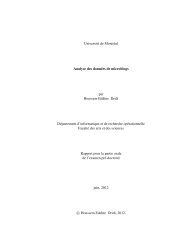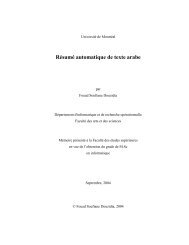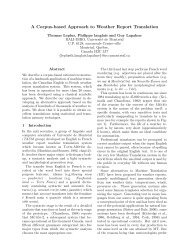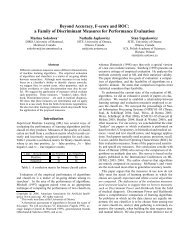Designing a Machine Translation System for Canadian Weather ...
Designing a Machine Translation System for Canadian Weather ...
Designing a Machine Translation System for Canadian Weather ...
Create successful ePaper yourself
Turn your PDF publications into a flip-book with our unique Google optimized e-Paper software.
<strong>Designing</strong> a <strong>Weather</strong> Warning <strong>Translation</strong> <strong>System</strong> 30<br />
on average. Starting the translation server involves loading in RAM the various<br />
statistical models and tools, and takes 10 s on average. Its design is relatively<br />
simple, and allows <strong>for</strong> simple maintenance and updates. Most of the resource files<br />
are in plain text, and can be modified readily. The statistical models however require<br />
retraining should the need arise to update them significantly.<br />
We implemented Watt as two translation servers, one <strong>for</strong> each source language.<br />
Each server uses a simple ad hoc communication protocol. This proved very useful<br />
in providing a centralized system, capable of translating requests originating from<br />
multiple points. <strong>Translation</strong>s can be sent to Watt from a demonstration website 9<br />
as well as from a command-line tool (<strong>for</strong> batch processing). Moreover, the latest<br />
prototype available at any time has been translating actual weather warnings in<br />
a staging environment, which is almost identical to the one Environment Canada<br />
currently uses. Studying the translation logs from these sources was instrumental in<br />
fine-tuning the numerous heuristics and rules embedded into Watt, and in adapting<br />
them to the evolving turns of phrase and vocabularies employed by meteorologists.<br />
8 Evaluations<br />
In order to properly assess an MT system’s per<strong>for</strong>mance, one cannot rely exclusively<br />
on automatic metrics such as BLEU, especially when the result is to be published<br />
by the Government of Canada <strong>for</strong> every <strong>Canadian</strong> to read, and when errors can<br />
have dire consequences. To remedy this, no less than four human evaluations were<br />
per<strong>for</strong>med on WATT, at different stages.<br />
The <strong>Translation</strong> Bureau at the request of Environment Canada carried out the<br />
first evaluation, in the summer of 2010. 135 weather warnings were then written<br />
<strong>for</strong> the occasion by meteorologists at EC, translated by a previous version of<br />
WATT and reviewed by translators from the Bureau. The study bluntly concluded<br />
that two thirds of the warnings produced definitely required human revision be<strong>for</strong>e<br />
publication. As the details of this evaluation were not communicated to the authors,<br />
it was difficult to use these findings to help improve the system.<br />
We thus per<strong>for</strong>med a second evaluation at the University, this time implementing<br />
a more state-of-the-art methodology, a sore point in the first study. This<br />
time, a blind evaluation was per<strong>for</strong>med by five human annotators (raters) who were<br />
asked to annotate source language sentences, as well as their respective human and<br />
machine translations, <strong>for</strong> 32 weather warnings (101 sentences) randomly selected<br />
from those issued during the summer of 2010. We used a clear ontology of errors,<br />
with distinct classes <strong>for</strong> meaning, <strong>for</strong>m, and typography. We showed that 66% of<br />
bulletins produced by WATT contain at least one fidelity flaw in their translation,<br />
compared to 25 % <strong>for</strong> human translations. The human per<strong>for</strong>mance put WATT’s<br />
in perspective. We also observed that 25 % of source sentences (inputs) contain at<br />
least one error and that this affected the quality of their translations (machine or<br />
human). The study further identified some shortcomings in WATT, which led to<br />
direct improvement in the following months.<br />
9 http://rali.iro.umontreal.ca/EnvironmentalInfo/Warning<strong>Translation</strong>.html











